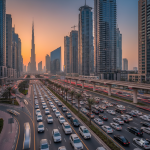In a move that could reshape urban road safety enforcement, Dubai has unveiled a fully autonomous Intelligent Traffic System (ITS) that uses artificial intelligence and real-time video analytics to detect, identify, and record major traffic violations — entirely without human intervention. The initiative marks a major milestone in Dubai’s journey toward becoming one of the world’s smartest and most technologically advanced cities.
What the System Does
The new ITS integrates high-resolution surveillance cameras, sensors, and advanced AI algorithms capable of detecting and documenting multiple categories of traffic violations in real time. Although officials have not disclosed the full list of offenses, such systems typically monitor for violations such as speeding, running red lights, illegal lane changes, mobile phone use while driving, and failure to follow road signals.
Once a violation is detected, the system automatically captures the evidence through images and video, time-stamps the incident, and stores it in a secure database for review and enforcement. Unlike traditional monitoring systems, this advanced platform requires no human operator to verify or record violations, thereby enhancing efficiency and accuracy.
Purpose and Benefits
The fully autonomous system is designed with several key objectives:
Enhancing Road Safety: By identifying dangerous driving behavior instantly, authorities can reduce traffic accidents and encourage compliance with traffic laws.
Modernizing Enforcement: The system minimizes human dependency in traffic monitoring and accelerates the enforcement process.
Real-Time Analytics: With continuous data collection, traffic authorities can analyze trends, identify high-risk areas, and predict congestion patterns for better planning.
Smart City Integration: The ITS aligns with Dubai’s broader goal of building a fully connected smart city powered by AI, automation, and sustainable technologies.
Integration with Dubai’s Smart Mobility Vision
The new ITS is part of a wider initiative by the Roads and Transport Authority (RTA) to integrate artificial intelligence into urban transportation. Earlier this year, Dubai introduced an AI-driven traffic signal control system designed to optimize traffic light timing and reduce congestion, particularly during rush hours.
Authorities have also been testing AI-assisted vehicle inspections and driver behavior monitoring systems, further demonstrating Dubai’s commitment to intelligent mobility solutions. Together, these innovations aim to create a seamless, data-driven transportation ecosystem that enhances efficiency and safety while reducing environmental impact.
Challenges and Considerations
Despite its promise, the system brings a set of challenges that authorities will need to address:
Accuracy and Reliability: AI detection must maintain high precision to avoid false positives or missed violations, especially when penalties are involved.
Privacy Concerns: Continuous surveillance raises questions about how data is stored, used, and protected. Clear regulations and transparency will be vital to ensure public trust.
Legal Framework: As violations are detected without human oversight, the legal system will need to define standards for evidence, appeals, and data use.
Public Awareness: Drivers must understand how the system works and be assured of its fairness and accuracy. Public education campaigns will be essential to encourage compliance.
Technical Robustness: The system must remain effective under varying weather and lighting conditions, as well as resilient against technical malfunctions or cybersecurity threats.
The Road Ahead
Authorities plan to roll out the ITS in stages, beginning with high-traffic zones and areas known for frequent violations. The system’s performance will be closely monitored, and AI models will be refined using real-world data to improve accuracy and adaptability.
In the future, the ITS may be integrated with Dubai’s public transportation network, smart parking systems, and emergency response units, creating a comprehensive traffic management infrastructure. This interconnectivity will allow the city to respond dynamically to traffic conditions, emergencies, and evolving transportation needs.
Conclusion
Dubai’s new fully autonomous AI traffic system represents a bold step forward in smart city development. By leveraging artificial intelligence to monitor and enforce traffic laws, the city is setting a global benchmark for urban governance and technological innovation.
While challenges related to privacy, regulation, and accuracy remain, the initiative reflects Dubai’s ongoing commitment to innovation, safety, and sustainability. As the system evolves, it could serve as a model for other cities seeking to combine technology, efficiency, and public safety in the era of AI-driven infrastructure.










